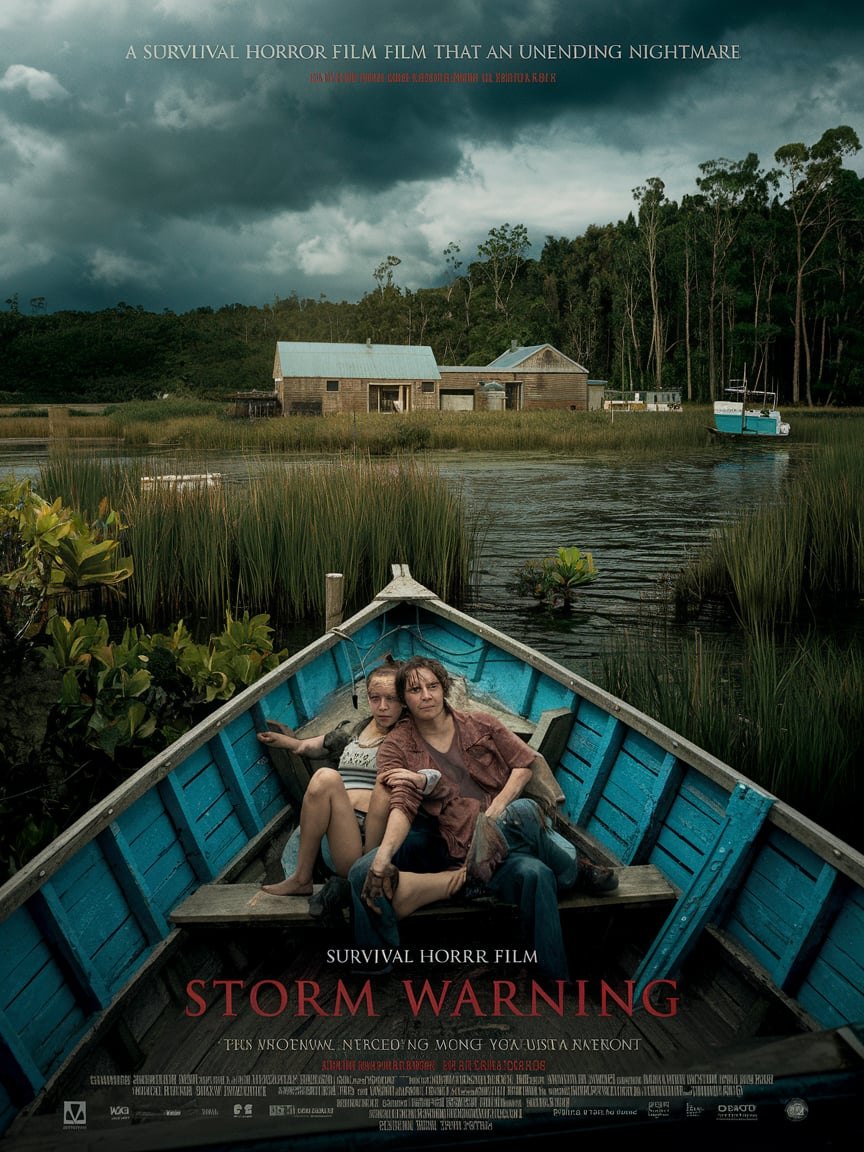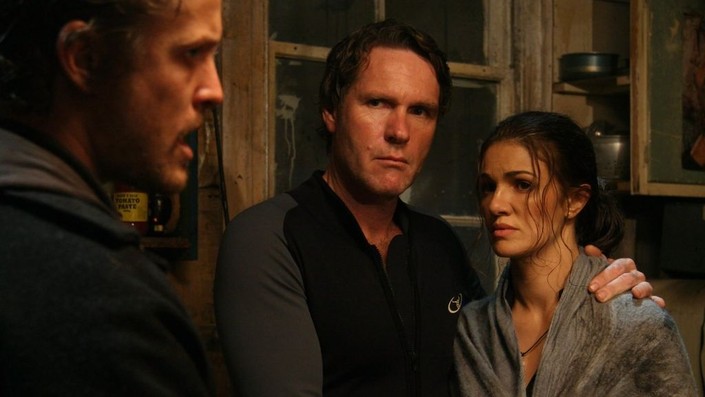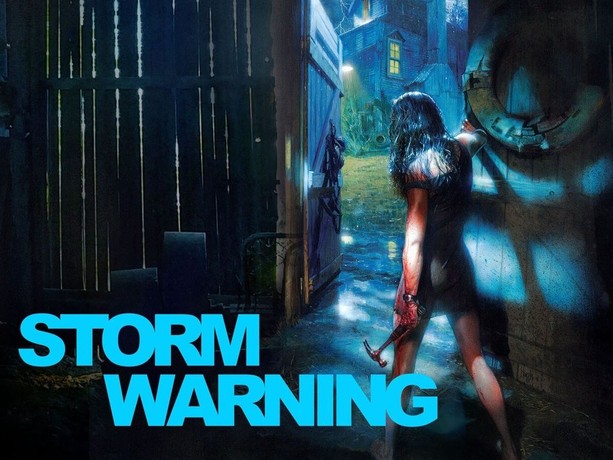Storm Warning (2007)

Storm Warning (2007): A Gory, Tense Horror That Lacks Breakthrough
Storm Warning (2007), directed by Jamie Blanks, is an Australian horror film that premiered on January 17, 2008, in Russia, later released on DVD by Dimension Extreme. With a low budget and an 86-minute runtime, it stars Nadia Farès, Robert Taylor, David Lyons, Mathew Wilkinson, and John Brumpton. The film follows an urban couple stranded in a swamp, facing a deranged family at a remote farm. Shot in Melbourne, Australia, it marks Blanks’ notable return after Hollywood flops like Urban Legend (1998). While delivering bloody violence and tension, Storm Warning stumbles with a familiar plot, shallow characters, and a slow start, settling as a temporary thrill. This review dissects every aspect to determine its worth.
Plot Summary: A Fight for Survival Amid Storm and Psychos
The film opens with a couple, Rob (Robert Taylor), an Australian lawyer, and Pia (Nadia Farès), his French wife, renting a small boat for a fishing trip off the coast. They get lost in a swamp as a storm brews, forcing them to seek shelter. After witnessing a man brutally beaten on the road, they flee and stumble upon a dilapidated farm with a large cannabis greenhouse. Soon, three rednecks return—brothers Jimmy (David Lyons), Brett (Mathew Wilkinson), and their father, Poppy (John Brumpton).
The trio quickly reveals their depravity. They mock Rob and Pia, using derogatory nicknames like “Volvo” and “Oui Oui,” forcing Pia to kill a baby kangaroo for amusement. As Rob and Pia try to escape, they discover the beaten man’s corpse. Brett breaks Rob’s leg, locking them in a shed. Pia, realizing she’ll be raped and they’ll both be killed, crafts deadly traps using hooks and sharp objects, killing Brett by hanging him and smashing his head.
Jimmy drags Pia inside, intending to hand her to Poppy for rape, but Pia fights back, smashing a bottle on Poppy’s head and grabbing the truck keys. As they flee, Poppy, bleeding, is mauled by his own Rottweiler. Jimmy pursues them in a motorboat, but Pia rams the truck into him, shredding him with the propeller. Rob and Pia drive off, ending with no explanation—a realistic but shallow close.
The plot splits into three acts: getting lost and seeking refuge, confronting evil, and a bloody revenge—simple yet tense, though unoriginal.

Production: Low Budget, High Ambition
With a low budget—estimated at a few million USD—Storm Warning was filmed at Central City Studios in Melbourne and Abruzzo, Italy, to recreate an Australian swamp. Blanks, after Hollywood setbacks, returned to an indie style, collaborating with screenwriter Everett De Roche, who penned the script 30 years prior. Producers Gary Hamilton and Pete Ford from Darclight Films backed it, alongside Resolution Independent.
Cinematographer Karl von Möller delivers a grim, horror-drenched look—misty swamps, a filthy house—crafting a stifling atmosphere. Practical effects dominate: fake blood and open wounds by Justin Dix and Gab Facchinei impress, though occasionally rough. The score, composed by Blanks, channels John Carpenter—heavy bass, heightening tension, but sometimes overpowering.
Edited by Geoff Hitchins, the film picks up pace after a slow start, though rushed cuts make some transitions clunky. Released via Dimension Extreme, the uncut version hit the U.S. on February 5, 2008, with audio commentary and behind-the-scenes features. It grossed $260,346 worldwide—a commercial flop, but it slowly gained a horror fanbase through streaming.

Performances: A Bright Spot in a Thin Script
Nadia Farès shines as Pia—a resilient woman shifting from fear to ferocity. Her trap-building and Brett’s brutal kill, with eyes both panicked and determined, stand out. Farès, in her first English lead role, brings charisma and toughness, though her character lacks depth. Robert Taylor as Rob, the injured husband, stays authentic—scared, helpless—but his role fades, mostly serving as Pia’s backdrop.
David Lyons and Mathew Wilkinson, as Jimmy and Brett, deliver believable psychopaths—Lyons with a crazed glare, Wilkinson with raw brutality. John Brumpton as Poppy, though briefly onscreen, is chilling with his cold cruelty—even his sons fear him. The villains’ performances feel real, though they don’t break the mold.
The actors fulfill their roles, but the script offers no room for growth—the leads lack appeal, the villains are just hateable. Farès is the highlight, but she can’t salvage the cast’s overall flatness.
Themes: Fear, Revenge, and Class Divide
Primal fear drives the film—an urban couple facing the lawless outback. Revenge fuels the second half—Pia, from victim to predator, reflects the oppressed striking back. Class divide is evident: the redneck family scorns Rob and Pia as “yuppie” elites, fueling cultural conflict between rural and urban.
Gendered violence lurks—the threat of Pia’s rape drives her fight, but the film doesn’t delve into her psyche, using it as shock value. Isolation—swamp, storm—amps the helplessness, but lacks deeper philosophy. The film leans on horror entertainment over message, a safe but limiting choice.
Strengths: Tension, Gore, and Atmosphere
Tension is the film’s strength—the slow start builds pressure: boat creaks, shapes in the swamp. When violence erupts, it’s unrelenting—Brett’s hook-trap death, blood pouring, is a gory highlight. The atmosphere excels—fetid house, cold swamp—recalling The Texas Chainsaw Massacre.
Practical effects shock—slashed wounds, torn corpses—satisfying gore fans. Farès and the villains keep it alive—Lyons and Wilkinson make you hate them, eager for their demise. At 86 minutes, it’s tight, focusing on action as pace ramps up. It’s an Aussie horror worth watching if you crave violence and revenge like Wrong Turn.
Weaknesses: Familiarity, Slowness, and Lack of Depth
The plot feels too familiar—the “couple stumbles into psycho territory” trope, overdone in The Hills Have Eyes or Wolf Creek. It offers no new ideas, relying on gore for impact. The first half drags—too many storm clouds, drifting boat scenes—unnecessarily long, testing patience.
Characters lack appeal—Rob and Pia aren’t compelling enough to root for, as Sean DeArmond from Horror News.net notes. The villains, while menacing, don’t break the redneck psycho mold—no clear motives beyond cruelty. The abrupt ending—Rob and Pia escape, no epilogue—feels hollow, lacking emotional resolution.
Violence sometimes oversteps—the gory revenge satisfies but overshadows psychology, veering into “torture porn” over true horror. Lack of innovation keeps it at entertainment level, leaving no lasting mark.

Reception: Praise and Criticism
Reception was mixed. On Rotten Tomatoes, it scores 37% (4 reviews), with audiences at 38%—too few reviews for a broad gauge, but it shows division. IMDb rates it 5.8/10—horror fans like Juli Norwood (Letterboxd, 5 stars) praise the creative violence, comparing Pia to Ripley in Alien. Amber Wilkinson (Eye for Film) lauds the fast pace, “outrageous” violence, and Blanks’ style—unoriginal but strong in its genre.
Conversely, Jason Buchanan (Allmovie) calls it unoriginal, lacking creativity. Sean DeArmond (Horror News.net) agrees the acting is solid but criticizes the slow start, unengaging leads, and overused storm visuals. On X, it’s dubbed “gory fun” but “generic”—fans of blood love it, those seeking novelty don’t.
Cultural Impact: A Minor Entry in Aussie Horror
Storm Warning adds to Australia’s “outback horror” wave—exploiting isolation and rural violence, like Wolf Creek or Razorback. The redneck family trope reflects urban fears of the countryside, but it’s also criticized for one-dimensional Aussie stereotypes. With low box office and limited release, it didn’t spark a wave, but it’s become a cult piece for horror fans on Tubi and Amazon.
It lacks the impact of The Texas Chainsaw Massacre or Deliverance, serving as a small example of Aussie horror—raw, bloody, unapologetic. Yet, its lack of innovation makes it a minor mark, not a movement.

Final Verdict: A Bloody Fight, Lacking Soul
Storm Warning is a horror worth watching if you like violence and revenge—tense, gory, with solid acting as its strengths. Farès shines, Blanks crafts a stifling atmosphere, and the hook-trap and Jimmy’s death linger. But the familiar plot, flat characters, and slow start keep it within B-movie bounds. It lacks Wolf Creek’s depth or The Hills Have Eyes’ haunting dread—just a bloody ride, quickly forgotten.
Score: 6.5/10. A horror flick for thrill-seekers, but not a lasting scare.